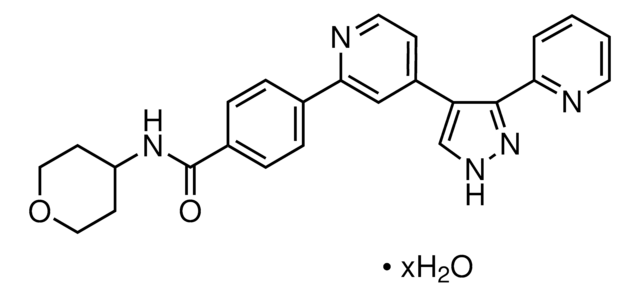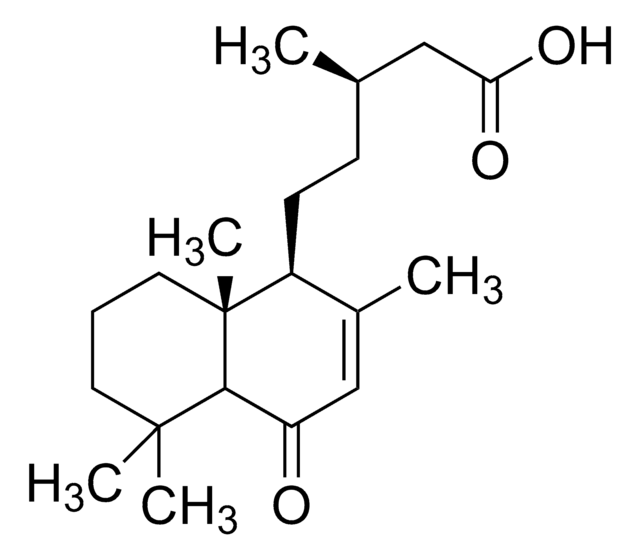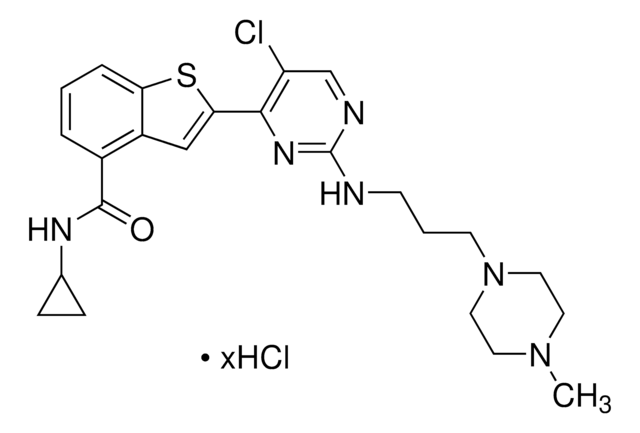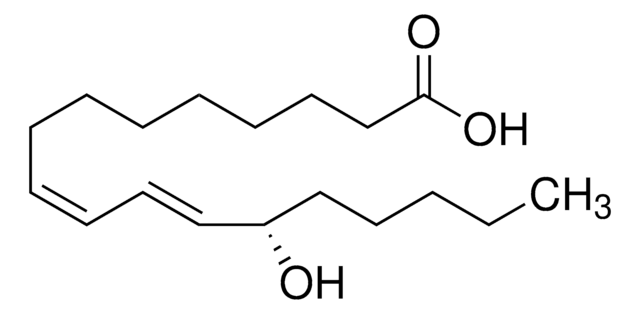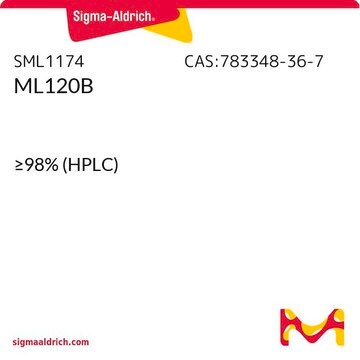H9146
13(S)-Hydroxyoctadeca-9Z,11E-dienoic acid
90-100 μg/mL in ethanol, ≥98%
Sinónimos:
13(S)-HODE
Iniciar sesiónpara Ver la Fijación de precios por contrato y de la organización
About This Item
Fórmula empírica (notación de Hill):
C18H32O3
Número de CAS:
Peso molecular:
296.44
Número CE:
Número MDL:
Código UNSPSC:
12352200
ID de la sustancia en PubChem:
NACRES:
NA.77
Productos recomendados
Nivel de calidad
Ensayo
≥98%
concentración
90-100 μg/mL in ethanol
temp. de almacenamiento
−20°C
cadena SMILES
CCCCC[C@H](O)\C=C\C=C/CCCCCCCC(O)=O
InChI
1S/C18H32O3/c1-2-3-11-14-17(19)15-12-9-7-5-4-6-8-10-13-16-18(20)21/h7,9,12,15,17,19H,2-6,8,10-11,13-14,16H2,1H3,(H,20,21)/b9-7-,15-12+/t17-/m0/s1
Clave InChI
HNICUWMFWZBIFP-IRQZEAMPSA-N
Acciones bioquímicas o fisiológicas
Expression of 15-lipoxygenase-1 (15-LOX-1) and its main product, 13(S)-HODE, are decreased in human colorectal and esophageal cancers. Certain non-steroidal anti-inflammatory drugs (NSAIDs) can induce apoptosis in human colon cancer cells by increased expression of 15-LOX-1, which down-regulates PPAR-delta through 13-HODE.
PPARγ agonist
Características y beneficios
This compound is featured on the Nuclear Receptors (PPARs) page of the Handbook of Receptor Classification and Signal Transduction. To browse other handbook pages, click here.
Envase
Packaged under Argon.
Palabra de señalización
Danger
Frases de peligro
Consejos de prudencia
Clasificaciones de peligro
Eye Irrit. 2 - Flam. Liq. 2
Código de clase de almacenamiento
3 - Flammable liquids
Clase de riesgo para el agua (WGK)
WGK 1
Punto de inflamabilidad (°F)
57.2 °F
Punto de inflamabilidad (°C)
14 °C
Elija entre una de las versiones más recientes:
¿Ya tiene este producto?
Encuentre la documentación para los productos que ha comprado recientemente en la Biblioteca de documentos.
Claus Schneider et al.
Cancer metastasis reviews, 30(3-4), 277-294 (2011-10-18)
Cancer initiation and progression are multistep events that require cell proliferation, migration, extravasation to the blood or lymphatic vessels, arrest to the metastatic site, and ultimately secondary growth. Tumor cell functions at both primary or secondary sites are controlled by
Shing Hwa Liu et al.
British journal of pharmacology, 160(8), 1963-1972 (2010-07-24)
Peroxisome proliferator-activated receptor-gamma (PPAR-gamma), COX-2 and 15-lipoxygenase (LOX)-1 have been shown to be involved in tumour growth. However, the roles of PPAR-gamma, COX-2 or 15-LOX-1 in gastric tumourigenesis remain unclear. Here, we investigate the role of 15-LOX-1 induction by honokiol
Ming-Yue Li et al.
American journal of respiratory cell and molecular biology, 43(6), 674-683 (2010-01-19)
Peroxisome proliferator-activated receptor (PPAR)-α and PPARγ participate in cell proliferation and apoptosis. Few studies have simultaneously investigated both PPARα and PPARγ in lung cancers in vivo. The roles of PPARα and -γ were investigated in the development of pulmonary tumors
Ulaganathan Mabalirajan et al.
Journal of applied physiology (Bethesda, Md. : 1985), 107(4), 1285-1292 (2009-07-25)
We showed recently that IL-4 causes mitochondrial dysfunction in allergic asthma. IL-4 is also known to induce 12/15-lipoxygenase (12/15-LOX), a potent candidate molecule in asthma. Because vitamin E (Vit-E) reduces IL-4 and inhibits 12/15-LOX in vitro, here we tested the
Anna Z Pollack et al.
American journal of epidemiology, 175(7), 645-652 (2012-02-04)
Exposures to cadmium, lead, and mercury are associated with adverse health effects, including cardiovascular disease, which may be promoted by lipid peroxidation. The authors examined cadmium, lead, and mercury in relation to plasma levels of F(2)-8α isoprostanes (isoprostane), 9-hydroperoxy-10,12-octadecadienoic acid
Nuestro equipo de científicos tiene experiencia en todas las áreas de investigación: Ciencias de la vida, Ciencia de los materiales, Síntesis química, Cromatografía, Analítica y muchas otras.
Póngase en contacto con el Servicio técnico